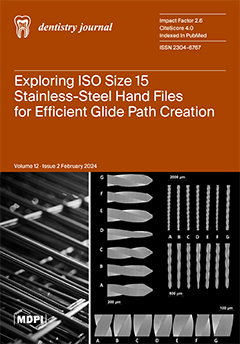Background: Digital technology has been introduced in prosthodontics, and it has been widely used in denture duplication instead of a conventional denture duplication technique. However, research comparing different denture duplication techniques and how they affect the fitting accuracy of the denture base is
[...] Read more.
Background: Digital technology has been introduced in prosthodontics, and it has been widely used in denture duplication instead of a conventional denture duplication technique. However, research comparing different denture duplication techniques and how they affect the fitting accuracy of the denture base is scarce. Objectives: The aim was to assess the impact of duplication techniques on the accuracy of the fitting surface of computer-aided design and manufacturing (CAD-CAM) milled, 3D-printed, and injection-molded complete denture bases (CDBs). Methodology: This study involved fabricating a mandibular complete denture base with three marked dimples as reference marks (A, B, and C at the incisive papilla, right molar, and left molar areas) using a conventional compression molded technique. This denture was then scanned to generate a standard tessellation language (STL) file; after that, it was duplicated using three different techniques (milling, 3D printing, and injection molding) and five denture base resin materials—two milled CAD-CAM materials (AvaDent and IvoBase), two 3D-printed materials (NextDent and HARZ Labs), and one injection-molded material (iFlextm). Based on the denture base type, the study divided them into five groups (each with
n = 10). An evaluation of duplication accuracy was conducted on the fitting surface of each complete denture base (CDB) using two assessment methods. The first method was a two-dimensional evaluation, which entailed linear measurements of the distances (A–B, A–C, and B–C) between reference points on both the scanned reference mandibular denture and the duplicated dentures. Additionally, a three-dimensional superimposition technique was employed, involving the overlay of the STL files of the dentures onto the reference denture’s STL file. The collected data underwent statistical analysis using a one-way analysis of variance and Tukey’s pairwise post hoc tests. Results: Both evaluation techniques showed significant differences in fitting surface accuracy between the tested CDBs (
p ˂ 0.001), as indicated by one-way ANOVA. In addition, the milled CDBs (AvaDent and IvoBase) had significantly higher fitting surface accuracy than the other groups (
p ˂ 0.001) and were followed by 3D-printed CDBs (NextDent and HARZ Labs), while the injection-molded (iFlextm) CDBs had the lowest accuracy (
p ˂ 0.001). Conclusions: The duplication technique of complete dentures using a CAD-CAM milling system produced superior fitting surface accuracy compared to the 3D-printing and injection-molded techniques.
Full article






